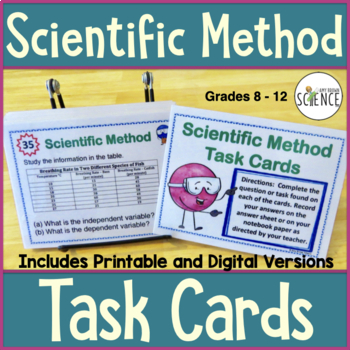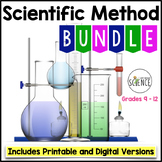Scientific Method Task Cards
- Zip
- Google Apps™

What educators are saying
Also included in
- Science Skills Mega Bundle: Graphing, Concept Mapping, Scientific Method, Metric System, Scientific Measurement, Lab Safety, Significant Digits, Analyzing Data, Graphic Organizers, Scientific Notation, Scientific Writing, and More!After many years of teaching, I have come to realize that what my stPrice $100.00Original Price $152.90Save $52.90
- This Scientific Method bundle includes everything you need to teach this unit. Students will learn how to apply the scientific method by practicing writing a hypothesis, identifying the independent and dependent variables, describing the control and experimental groups, graphing and analyzing data,Price $25.99Original Price $34.22Save $8.23
Description
This set of 45 task cards is designed to teach, review, and reinforce the APPLICATION of the scientific method. Students will write hypotheses, identify independent and dependent variables, describe experimental and control groups, read tables and graphs, form conclusions, make predictions, and more. Choose to use the traditional printable version, or the paperless, digital Google Apps version. Both Google Slides and Google Forms versions are included.
This resource is perfect for distance learning and for students in 1:1 classrooms.
Click this link to view all of my Digital Resources.
What is included in this resource?
- Teacher Guide containing tips, directions, and suggestions.
- A set of 45 task cards in editable and pdf formats.
- Full page Graph diagram to be used with task cards 42 - 45.
- A student answer sheet for recording answers.
- Blank task cards so that you can add additional questions.
- A complete teacher answer key.
- A teacher answer key PowerPoint that can be used to go over answers with the students.
- Paperless Digital Version for use in Google Drive, Google Classroom, and/or Microsoft OneDrive.
- Google Slides Version (not editable)
- Google Forms Version (editable)
Task cards are a fantastic way to reinforce lessons, review difficult concepts, or provide extra practice for the struggling student. The student reads each card, performs the task, and records his/her answer on the included student answer sheet.
From the moment of purchase, you will be ready to use your task cards in just a few minutes. Simply print the sheets of task cards on card stock paper, laminate, and cut the cards apart. The cards look best when printed in color, but they can easily be printed in black and white.
This set of 45 task cards on the scientific method will cover the following:
- The student will list the steps of the scientific method.
- The student will distinguish between quantitative and qualitative data.
- The student will define the term “hypothesis” and will demonstrate the ability to write a suitable hypothesis for an experiment. Scenarios are given and students must write a suitable hypothesis.
- The student will demonstrate an understanding of the term “controlled experiment.”
- The student will distinguish between experimental and control groups in an experiment.
- Given a lab experiment scenario, students will describe possible experimental groups and control groups.
- The student will distinguish between independent and dependent variables. Many examples are given which ask the student to identify the independent and the dependent variables.
- Given a lab experiment scenario, the student will list factors that must be kept constant in the experiment.
- The student will look at a graph and form a conclusion based on the information on the graph.
- The student will study the information in a data table and identify the independent and dependent variables, and form a conclusion.
- Given a line graph, students will identify the independent and dependent variables, and use the graph to make predictions.
Related products include:
- Scientific Method Google Sheets Hidden Picture Reveal Activity
- Scientific Method Color By Number
- Scientific Method Crossword Puzzle
- Scientific Method Unit Test
- Introduction to Science: 34 Warm ups, bell ringers, or inserts for science interactive notebooks
- Common Core Science: Informational Reading Task Cards for ANY Science Reading Passage
- Boom Cards (Digital Task Cards) on The Scientific Method
- Biology Buzz Words: Introduction to Biology
- Scientific Method Back to School Color by Number Activity
- Scientific Method PowerPoint with Notes for Teacher and Student
- Scientific Method Homework and Study Guide
- Graphing and Scientific Method Practice Problems
- What's In a Name? (A Study of Biological Prefixes and Suffixes)
- Scientific Method Lab: The Student Designed Experiment
For updates about sales and new products, please follow my store:







